You can help expand this article with text translated from the corresponding article in French. (April 2022) Click for important translation instructions.
|
| Laurent de La Hyre | |
|---|---|
| Born | (1606-02-27)27 February 1606 Paris, Kingdom of France (now France) |
| Died | 28 December 1656(1656-12-28) (aged 50) Paris |
| Nationality | French |
| Known for | Painting |
| Movement | Classicism Baroque |
Laurent de La Hyre (French pronunciation: [loʁɑ̃ də la iʁ]; 27 February 1606 – 28 December 1656) was a French Baroque painter, born in Paris. He was a leading exponent of the neoclassical style of Parisian Atticism.
Life

La Hyre was greatly influenced by the work of Italian artists who came to Paris. He became a pupil of Georges Lallemand and studied the works of Primaticcio at Fontainebleau, but never visited Italy. La Hyre's captivating use of color and delicately posed figures are a trademark of his early, painteresque style. He was an innovative artist who used his superior skills as a storyteller to portray rarely depicted subjects. La Hyre is associated with the transitional period before the introduction of the French Baroque by Simon Vouet.
His picture of Pope Nicholas V opening the crypt in which he discovers the corpse of St. Francis of Assisi standing (located at the Louvre) was executed in 1630 for the Capuchin friars of the Marais; its gravity and sobriety seems to have been influential for the next generation of French painters, particularly Eustache Le Sueur. The Louvre contains eight other works, and paintings by La Hyre are in the museums of Strasburg, Rouen and Le Mans.

His drawings, of which the British Museum possesses a fine example, Presentation of the Virgin in the Temple, are treated as seriously as his paintings, and sometimes show simplicity and dignity of effect. The example of the Capuchins, for whom he executed several other works in Paris, Rouen and Fécamp, was followed by the goldsmith's company, for whom he produced in 1635 St. Peter healing the Sick (Louvre) and the Conversion of St Paul in 1637.
In 1648, La Hyre was one of the founders of the French Royal Academy of Painting and Sculpture and was elected as one of the original twelve elders in charge of its running.
Richelieu called La Hyre to the Palais Royal; Pierre Séguier, Gédéon Tallemant des Réaux and many others entrusted him with important works of decoration; for the Gobelins he designed a series of large compositions. La Hyre painted also a great number of portraits, and in 1654 united in one work for the town-hall of Paris those of the principal dignitaries of the municipality. His students included François Chauveau.
Works by Laurent de La Hyre
- Mythological and other themes
-
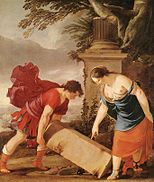 Theseus and Aethra
Theseus and Aethra
-
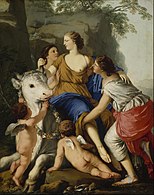 The Rape of Europa
The Rape of Europa
-
 Regency of Anne of Austria
Regency of Anne of Austria
-
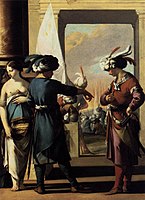 Cyrus Announcing to Araspas that Panthea Has Obtained His Pardon
Cyrus Announcing to Araspas that Panthea Has Obtained His Pardon
-
 Cornelia Refuses The Crown of The Ptolomai (1646)
Cornelia Refuses The Crown of The Ptolomai (1646)
-
 Hercules and Omphale (1626)
Hercules and Omphale (1626)
- Seven Liberal Arts
-
 Allegory of Astronomy (1649)
Allegory of Astronomy (1649)
-
 Allegory of Geometry (1649)
Allegory of Geometry (1649)
-
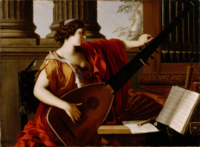 Allegory of Music (1649)
Allegory of Music (1649)
-
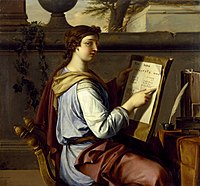 Allegory of Arithmetic (1650)
Allegory of Arithmetic (1650)
-
 Allegory of Dialectic (1650)
Allegory of Dialectic (1650)
-
 Allegory of Grammar (1650)
Allegory of Grammar (1650)
-
 Allegory of Rhetoric (1650)
Allegory of Rhetoric (1650)
- Biblical themes
-
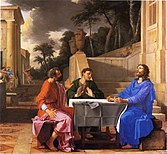 Christ in Emmaus
Christ in Emmaus
-
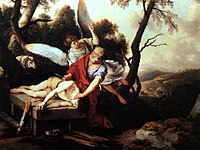 Abraham Sacrificing Isaac
Abraham Sacrificing Isaac
-
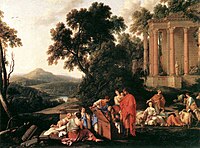 Laban Searching Jacob's Baggage for the Stolen Idols
Laban Searching Jacob's Baggage for the Stolen Idols
-
 Jesus Appearing to the Three Marys
Jesus Appearing to the Three Marys
References
- ^ Encyclopædia Britannica, 1911
- Mémoires pour servir à l'histoire de l'Académie royale de Peinture et de Sculpture depuis 1648 jusqu'en 1664, Ed. Anatole de Montaiglon, Paris 1853, vol. I, p. 36.
Sources
 This article incorporates text from a publication now in the public domain: Chisholm, Hugh, ed. (1911). "Lahire, Laurent de". Encyclopædia Britannica. Vol. 16 (11th ed.). Cambridge University Press. p. 80.
This article incorporates text from a publication now in the public domain: Chisholm, Hugh, ed. (1911). "Lahire, Laurent de". Encyclopædia Britannica. Vol. 16 (11th ed.). Cambridge University Press. p. 80.
Birmingham Museum of Art (2010). Birmingham Museum of Art Guide to the Catalog. London: Giles. 9781904832775.
External links
 Media related to Laurent de La Hyre at Wikimedia Commons
Media related to Laurent de La Hyre at Wikimedia Commons- Orazio and Artemisia Gentileschi, a fully digitized exhibition catalog from The Metropolitan Museum of Art Libraries, which contains material on Laurent de La Hyre (see index)
- A Caravaggio Rediscovered, The Lute Player, an exhibition catalog from The Metropolitan Museum of Art (fully available online as PDF), which contains material on La Hyre (see cat. no. 19)